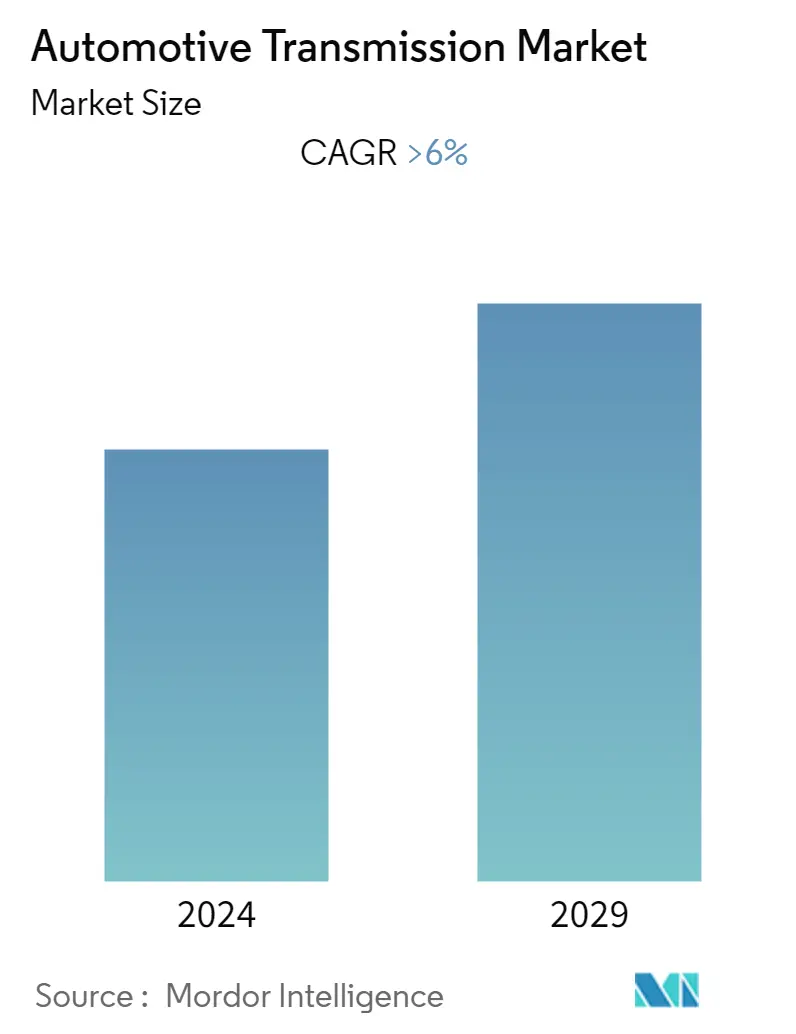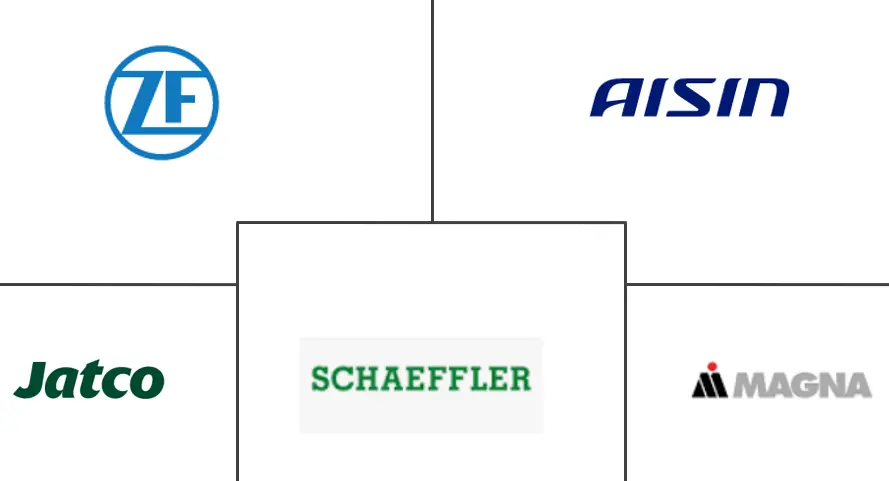Market Size of Automotive Transmission Industry

| Study Period | 2019 - 2029 |
| Base Year For Estimation | 2023 |
| CAGR | 6.00 % |
| Fastest Growing Market | Asia-Pacific |
| Largest Market | Asia-Pacific |
| Market Concentration | Medium |
Major Players
*Disclaimer: Major Players sorted in no particular order |
Automotive Transmission Market Analysis
The Automotive Transmission Market was valued at USD 180.3 billion in 2021 and USD 257.3 billion in 2027 and is expected to register a CAGR of ~6% during the forecast period (2022 - 2027).
The COVID-19 pandemic led the majority of businesses globally to collapse in the year 2020, owing to the compulsory suspension of manufacturing and production operations, which impacted key manufacturing companies globally. This is also had a negative impact on the automotive transmission market. However, increased vehicle demand has been observed in past recent months, enabling the rise of the automotive transmission market after the outbreak of COVID-19.
Rapid technical improvements in automobile transmission production, as well as customers' rising preference for a pleasant driving experience, will boost demand for the automotive transmission market throughout the projected period. Furthermore, lightweight transmission systems lower the weight of the vehicle in proportion, ensuring that it meets severe pollution and fuel efficiency standards. The widespread adoption of AMT, with the increasing popularity of autonomous vehicles. This tendency has been helped by improved fuel economy, increasing traffic circumstances, and the progressive elimination of myths regarding automated vehicles. The automatic transmission provides easy and smooth gear changes, and lower fuel consumption adds to driving comfort.
Raw material price variations might make the market less competitive. Weight-reducing alloys and lightweight materials are costly, but they are important in the development of efficient and lightweight transmissions. One of the primary constraints for manufacturers is the high cost of raw materials, which leads to the high cost of transmission systems. This is primarily due to consumers' preference for cost-effectiveness vehicle above performance majorly in the emerging regions.
Asia-Pacific is expected to dominate worldwide automotive transmission industry owing to increased production of passenger cars and light commercial vehicles in the region's growing economies, . Many OEMs are willing to establish manufacturing facilities in this region, particularly in rising markets like as China and India. During the projection period, North America is predicted to be the second biggest market.
Automotive Transmission Industry Segmentation
It is a multi-speed gearbox used in vehicles where the driver does not need to change forward gears under typical driving conditions. A planetary gearset, hydraulic controls, and torque converter are included. The engine is linked to a torque converter, which is linked to a gear system, which is ultimately linked to the gearbox. Some sections of the torque converter interact with one another. The flywheel, which rotates the whole device, is housed in the outermost section.
The automotive transmission market is segmented by transmission type, vehicle type, fuel type, and geography.
The Automotive Transmission Market is segmented by By Transmission Type, the market is segmented into Manual Transmission, Intelligent Manual Transmission (IMT), Automated Manual Transmission (AMT), Automatic Transmission (AT), Dual-clutch Transmission, and Others. By Vehicle Type, the market is segmented into Passenger Cars, Light Commercial Vehicles, and Heavy Commercial Vehicles. By fuel type, the market is segmented into Gasoline and Diesel. By Geography, the market is segmented into North America, Europe, Asia-Pacific, and the Rest of the World. For each segment, market sizing and forecast have been done on basis of value (USD billion).
| Transmission Type | |
| Manual Transmission | |
| Intelligent Manual Transmission (IMT) | |
| Automated Manual Transmission (AMT) | |
| Automatic Transmission (AT) | |
| Dual-clutch Transmission | |
| Other |
| Vehicle Type | |
| Passenger Cars | |
| Light Commercial Vehicles | |
| Heavy Commercial Vehicles |
| Fuel type | |
| Gasoline | |
| Diesel |
| Geography | ||||||||
| ||||||||
| ||||||||
| ||||||||
|
Automotive Transmission Market Size Summary
The automotive transmission market is poised for significant growth, driven by rapid technological advancements and increasing consumer demand for enhanced driving experiences. The market is experiencing a resurgence following the disruptions caused by the COVID-19 pandemic, which had temporarily hindered production and manufacturing activities. The shift towards lightweight transmission systems is gaining momentum, as these systems contribute to improved fuel efficiency and reduced emissions, aligning with stringent environmental standards. The adoption of automated manual transmissions (AMTs) and automatic transmissions (ATs) is on the rise, fueled by the growing popularity of autonomous vehicles and the need for fuel-efficient solutions. These developments are creating substantial opportunities for market expansion, particularly in regions like Asia-Pacific, where the demand for passenger cars and light commercial vehicles is robust.
The Asia-Pacific region is expected to dominate the global automotive transmission market, with China playing a pivotal role in its growth. The region's burgeoning economies are witnessing increased vehicle production, prompting original equipment manufacturers (OEMs) to establish manufacturing facilities to meet the rising demand. North America is anticipated to be the second-largest market, driven by investments in advanced transmission technologies. However, the market faces challenges such as raw material price fluctuations, which could impact competitiveness. Despite these challenges, the market remains moderately consolidated, with key players like ZF Friedrichshafen AG, Aisin Corporation, and JATCO Ltd. leading the charge. These companies are actively engaging in strategic partnerships, product launches, and investments to enhance their market positions and drive innovation in transmission technologies.
Automotive Transmission Market Size - Table of Contents
-
1. MARKET DYNAMICS
-
1.1 Market Drivers
-
1.2 Market Restraints
-
1.3 Porters 5 Force Analysis
-
1.3.1 Threat of New Entrants
-
1.3.2 Bargaining Power of Buyers/Consumers
-
1.3.3 Bargaining Power of Suppliers
-
1.3.4 Threat of Substitute Products
-
1.3.5 Intensity of Competitive Rivalry
-
-
-
2. MARKET SEGMENTATION
-
2.1 Transmission Type
-
2.1.1 Manual Transmission
-
2.1.2 Intelligent Manual Transmission (IMT)
-
2.1.3 Automated Manual Transmission (AMT)
-
2.1.4 Automatic Transmission (AT)
-
2.1.5 Dual-clutch Transmission
-
2.1.6 Other
-
-
2.2 Vehicle Type
-
2.2.1 Passenger Cars
-
2.2.2 Light Commercial Vehicles
-
2.2.3 Heavy Commercial Vehicles
-
-
2.3 Fuel type
-
2.3.1 Gasoline
-
2.3.2 Diesel
-
-
2.4 Geography
-
2.4.1 North America
-
2.4.1.1 United States
-
2.4.1.2 Canada
-
2.4.1.3 Rest of North America
-
-
2.4.2 Europe
-
2.4.2.1 Germany
-
2.4.2.2 United Kingdom
-
2.4.2.3 France
-
2.4.2.4 Italy
-
2.4.2.5 Spain
-
2.4.2.6 Rest of Europe
-
-
2.4.3 Asia-Pacific
-
2.4.3.1 India
-
2.4.3.2 China
-
2.4.3.3 Japan
-
2.4.3.4 South Korea
-
2.4.3.5 Rest of Asia-Pacific
-
-
2.4.4 Rest of World
-
2.4.4.1 South America
-
2.4.4.2 Middle-East and Africa
-
-
-
Automotive Transmission Market Size FAQs
What is the current Automotive Transmission Market size?
The Automotive Transmission Market is projected to register a CAGR of greater than 6% during the forecast period (2024-2029)
Who are the key players in Automotive Transmission Market?
ZF Friedrichshafen AG, Aisin Corporation, Hyundai Transys Co., Ltd., JATCO Ltd and Musashi Seimitsu Industry Co., Ltd. are the major companies operating in the Automotive Transmission Market.

